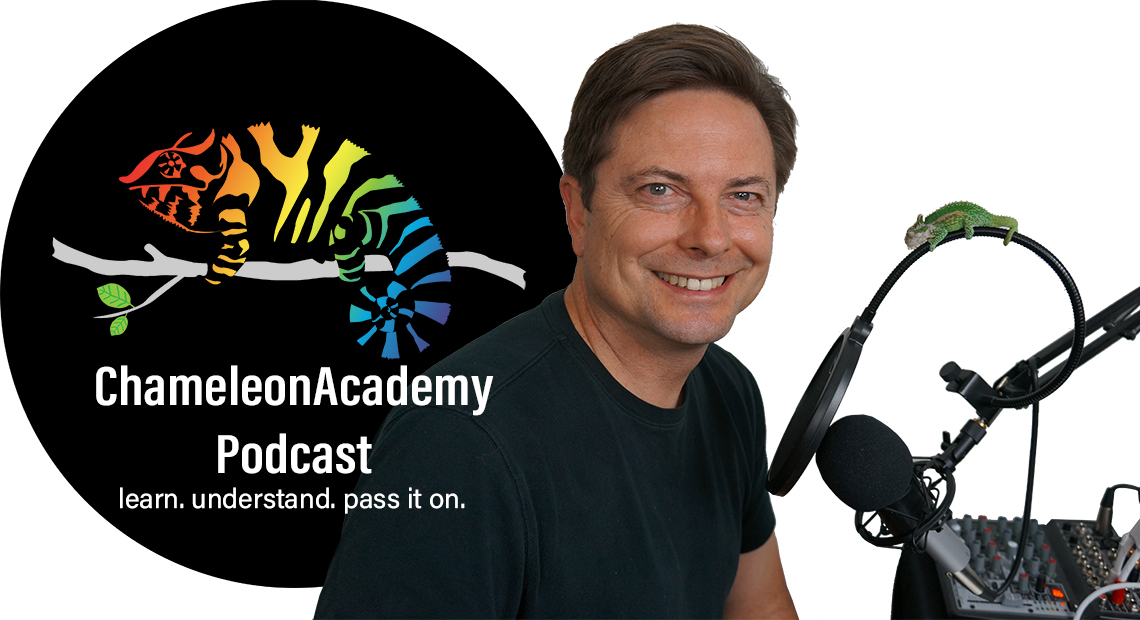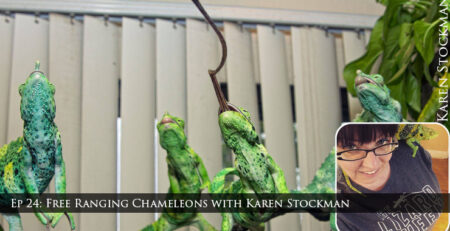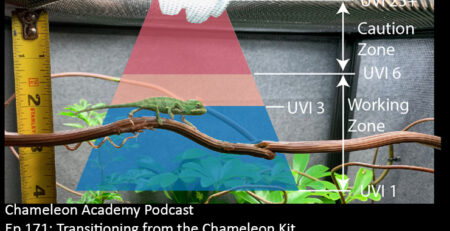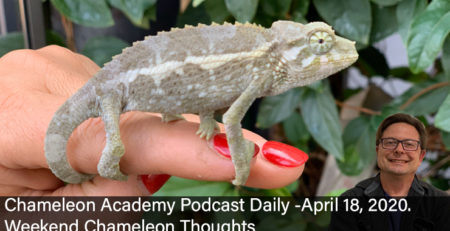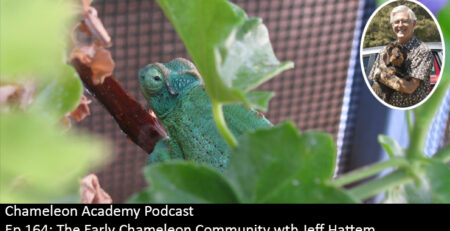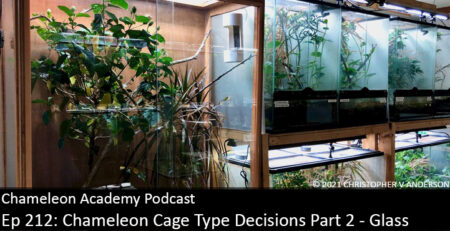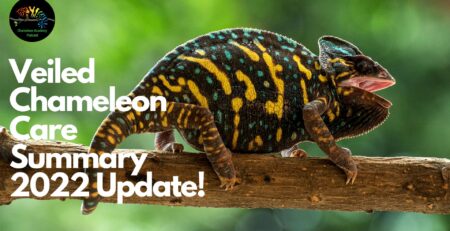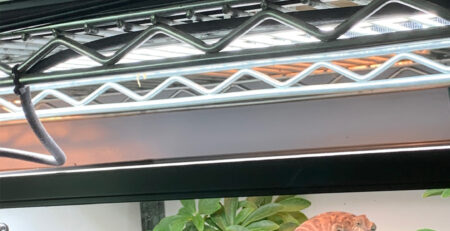Ep 215: Using Wild Conditions in Chameleon Husbandry
Listen Here!
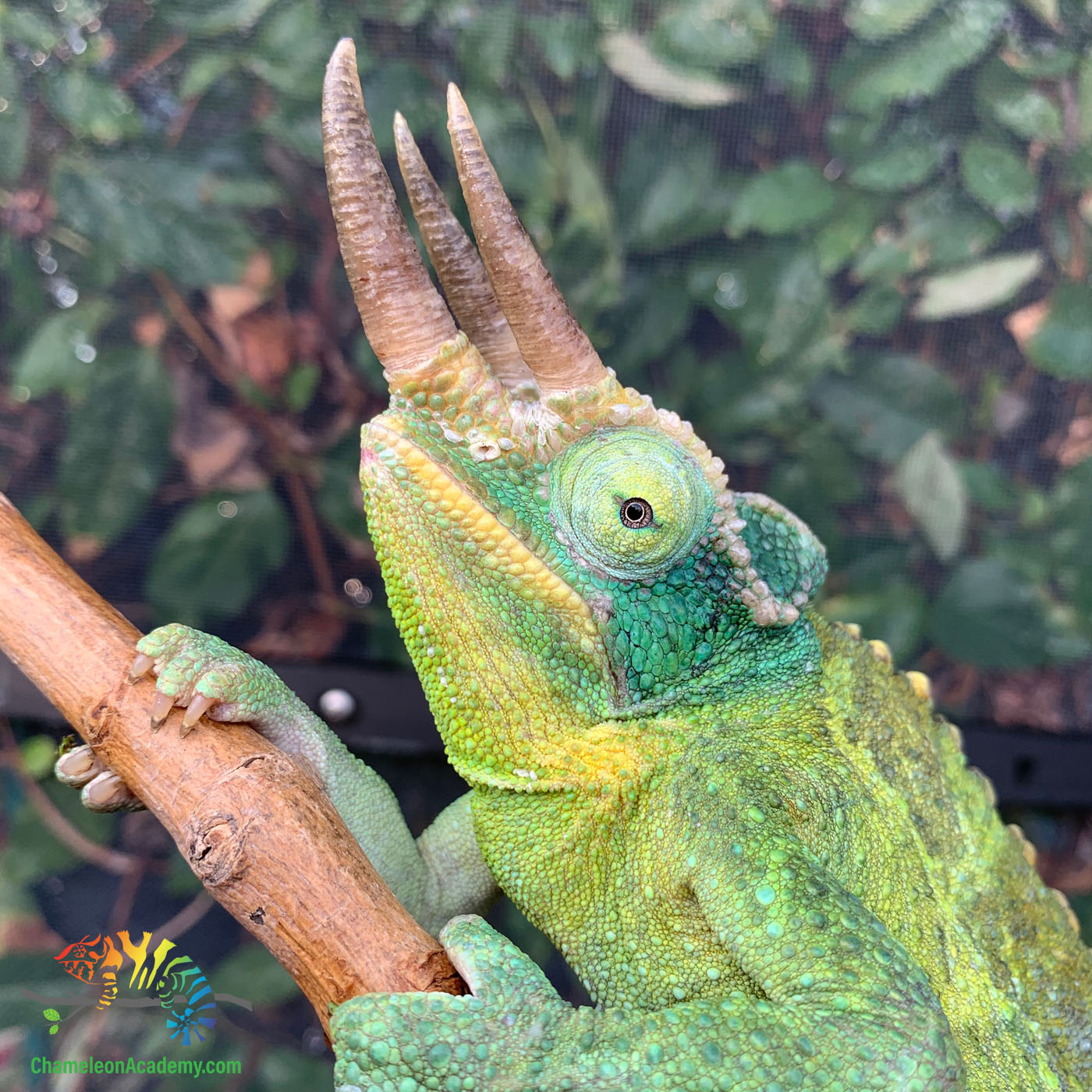

Bill Strand
Ep 215: Using Wild Conditions in Chameleon Husbandry
Those of us dedicated to the art of chameleon husbandry have recreating the ideal conditions as our primary goal. Determining ideal conditions starts with understanding the wild conditions our chameleon species developed within. But then it must be translated into an execution in our captive environment. Today I talk about how we extract ideal conditions from wild environmental data and what the limitations of doing that are.
Links from the episode
Transcript (More or Less)
Hello Chameleon Wranglers! Today we are going to look at the process of sifting through all the wild environmental data from our chameleon’s home region to figure out what we should put on our care sheets. And we are also going to go head to head with the fact that there comes a time when we have to do further study within our captive environment. Don’t worry, I’ll explain what I mean by that in this podcast.
The Chameleon’s Original Environment: Our Most Valuable Reference.
It will come as a surprise to no one that the chameleon’s original environment, where they spent millions of years adapting to, and becoming dependent upon, certain conditions becomes the foundation of determining the ideal husbandry. But there is some extraction and analysis that we are required to perform. We are simply not able to recreate the wild conditions in their entirety. Not only do the weather patterns constantly change, the chameleon changes its position within those constantly variable conditions. So just determining what those perfect conditions are is immensely complicated because you have to understand all the micro-climates that a chameleon has access to.
For a very basic and simple example. It may be 95 degrees F outside at the weather station taking the data. But our intrepid chameleon has retreated back into the dense shade where it can be downright cool. I think it is obvious that the weather station data is of limited value. The data taken where the chameleon is throughout the day is much more valuable, and much less accessible. Even viewing the chameleon basking in 95 degree weather is not evidence that we should be giving them a 95 degree basking point or that ambient temperature should be anywhere near that. The ability to retreat into dense shade makes deadly temperatures just part of the every day life experience.
This is why the larger the cage you make it, and the more microclimates you can create, the more swings in ambient temperature your chameleon can handle. By restricting our chameleon from roaming far and wide we drastically cut down on his available options to regulate his comfort. It is important to know that if you go back to the home country which should have perfect conditions and put a chameleon in a cage out in the sun you will most likely kill it. Because, even the home conditions are not ideal. There will be unbearably hot days and extended dry seasons that will kill chameleons. So there is no such thing as ideal conditions in the wild. There is a fluctuation of conditions which, on the average allow the chameleon to find microclimates to sustain himself. So, what does this mean for us? Is there such thing as ideal conditions? And how can we figure out what those ideal conditions are?
Is there such thing as ideal conditions? The answer is yes. There is. Or at least, there are a set of conditions that we can recreate in captivity that are a close enough approximation to ideal. And we continue to refine these conditions the more we learn. Our measuring stick is vitality and longevity. When you hear people talk about male panther or veiled chameleons having a four year lifespan you know that the overall husbandry conditions were not ideal. But there was a time when this was an achievement. Today, seven years can be reasonably expected and ten years is for congratulations. But I am hearing reports of panthers and veileds that are living beyond ten years so we still have a lot of work to do! The goal is to bring ten year lifespans to the mainstream. This is why my care summaries on the Chameleon Academy website change every year or every time I learn a nuance or better way of describing a husbandry technique. It is because they are living documents. And they will be until the combination of environmental and dietary conditions have been hammered down enough that a ten year longevity is routine if you follow the care summary.
How do we determine ideal conditions?
Getting information from the field is critical to start us in the right direction. But we must then start testing. We throw out the extremes because it isn’t a stretch to know that those are in the tolerance zone. We look at the averages and start with those. The thing is that we don’t always get it right to begin with. In fact, all you old timers, raise your hand if you specifically kept your Jackson’s Chameleon from getting too cold at night. Where cold is in the 60s? Yep, I was part of the generation that put together the care sheets you have now through our mistakes.
So, that begs the question. If it is so easy to go off in the wrong direction, how do we determine what the ideal conditions are? And here it comes back to testing. We take the conditions we think are the ones we want to try and we try them. If the chameleons live long and healthy we have a data point that says these conditions are valid for X years of life. And then you or other people tweak those parameters and either they get better or worse or the same results. Okay, another data point. Because we are trying to figure out conditions that are average and will work for the most number of keepers we have to repeat this test over many individuals and over generations. This is not usually something a single breeder can pull off! This is a community efforts over years and decades. This is why it takes a great deal of time to come up with care sheet parameters. And this is a core reason why I started this podcast in the first place. I wanted to gather the experiences of people from around the world.
Captivity is different
In this exploration, we have to understand that we will be experimenting with things that go beyond wild conditions.
Even though the wild conditions are our gold standard there is only so far they can take us before we need to stop talking about them and bring them back to the vivarium to figure out how they relate to our situation. As an example, let’s circle back around to our good friend UVB.
How much do chameleons need? How is it connected to heat? How much do chameleons seek out UVB when it is separated from a heat source? How accurate can the chameleon gauge how much UVB they need? You would think that their body would have figured it out after all this time, but we have really messed that up with changing everything on them. We have taken the sun, split it into three separate lights and created heat and UVB gradients that they can move in and out of within inches on their basking branch. This is not natural so any natural gauge their body has now has to adjust to light sources that have different spectrums and intensities. We see this with heat bulbs. Chameleons will sit under heat bulbs that are too hot and burn themselves. And they will continue to do it. So there is something that is messing with their sense of self-preservation that works perfectly out in the wild. So, it is logical that we should consider that there may be similar issues with UVB. We don’t know. Maybe the spectrum of our lamps happens to correspond perfectly with what the chameleon’s body is looking for. Maybe the body is an excellent judge of vitamin D3 levels in the blood. We do not know and we need to be open to all possibilities.
Scientific papers give excellent insight, but because chameleons have their own mind and we have no idea why they choose to do what they do, we as hobbyists need to figure out how to implement the findings in our environments. When scientific papers are written regarding UVB or vitamin D3 these chameleons are forced into situations which remove as many variables as possible. So, figuring out how much D3 a chameleon needs to be healthy by orally dosing them with measured vitamin D3 may produce a number, but how useful is that when we, in the real world, are using powders of vitamin D3 and vitamin A which are dusted on insects. Powder is lost, the effects of the vitamins are different because they are given together, and the composition of the feeder insect may or may not change the outcome. So, once the scientists are done with their controlled experiments and extrapolations we have a lot of work to do on our end to figure out what it means in the real world of much larger cages.
Figuring out how chameleon behavior dictates the conditions we give them is a whole discipline in itself.
Do you want to see this happening in real time? I’ll let you in on something that will be changing in the coming years as far as husbandry. You will start to hear more about UVB doses. A UVB dose is the intensity of UVB, or the UV Index, multiplied by the length of time the light is given. So, if you use UVI 3 for 12 hours you have a UVB dose of 36. But the chameleon does not use the UVB light for all 12 hours. So, it is reasonable to have the UVB light on for only…what, 4 hours? 2 hours? I don’t know, but something less than 12. So, will a UVB dose of 12 instead of 36 give the same results? Is UVI 3 for four hours the same as UVI 4 for three hours? Presumably, there is a lower limit to where the UV Index just doesn’t energize the D3 synthesis any more. And we know we don’t want to give UVI 12 for one hour because UVB damages skin and organs. So there is going to be a working range of levels and lengths of time exposure.
The reason why you haven’t heard much about the concept of dose on this podcast is because it was an enormous effort to determine that UVI 3 over 12 hours was sufficient for Veileds and panthers. Adding the variable of time, in other words, changing the length of time instead of having it fixed, would have made it difficult to establish UVI 3 as a landmark. But now it is time to explore further. The next step is dose. Dr. Gary Ferguson’s latest scientific paper on chameleons experiments with different doses of UVB. One of Petr Necas’ YouTube videos on UVB speaks of a breeder in Europe who has experimented with doses in his colony. So the concept will continue to gain momentum. Expect it to be challenged as any new idea is, and should be, but there it is. You have a front row seat to the development of a new idea. And, yes, the caresheets of five years from now on the Chameleon Academy will be different. Because this is a good idea and I am going to work with it. It will be years before you start seeing this on the Chameleon Academy because it will take that long to lay down some guidelines that I could feel comfortable sharing with others to try. I am raising up my panther chameleon breeding group and, when they hatch, I will work with different values. I’ll work with females because my standard is the ability to lay completely calcified clutches of eggs with no dietary D3. If anyone out there wants to work on this before I have my group in place you are welcome to reach out to me and work with me on this. I know the key to solid reliable information is the patience to do it right. But I encourage those who are interested in such things and in a position to experiment now to go for it. I mean, once I come up with something it is only a data point until others reproduce it. So, I don’t mind being the one to reproduce your initial data. That will save time. We’ll need a handful of experimenters before we can be confident enough to put it in care sheets. Anyway, have fun watching the introduction of a new idea into the community! It is always a fun thing.
Now, I’d like to address two special cases. Both Veiled Chameleons and Jackson’s Chameleons have established populations outside of the natural range. And since both their natural ranges are either difficult or life threatening to visit, the idea is often floated to study them in their introduced ranges. This is not reliable, but it takes a little explaining as to why this is so it is worth spending the time on this now.
First, let’s talk about the Veiled Chameleon.
Example: Veiled Chameleon. Even just five years ago, the prevailing thought was that Veileds were harsh, arid conditions. High heat and high UVB. I spent years trying to find an eye witness to ask them what it was really like and when I finally did, I found a completely different story that ruined what I thought. It wasn’t harsh at all. It was actually a lush oasis. What I found, and you can follow my journey on this podcast because I published my entire exploration, is that they hatched at the beginning of the rainy season in valleys in the mountains which sprang to life with vegetation. They hid during the day’s sun. And in these mountain mountainous regions they experienced fog banks in the morning, mild temperatures, and cool nights.
Is this report of Veiled Chameleon environment 100% the best we will ever have? I don’t know. Maybe when the civil war in Yemen is over, more of us can visit the area and our understanding will improve. We will either confirm what we have heard from Petr Necas, Martin Wendche, and Petko Dvorak, my three eye witnesses to Veiled Chameleon’s in the wild, or we will discover a deeper understanding with more eyes and minds on the ground. But, the fact is, that these three eye witness accounts in Yemen are the best source of information I have right now.
But what about Veiled Chameleon’s in Florida? They have naturalized there so can’t we just study where they are in Florida and study those parameters? The answer is not really. We can learn more about their tolerance range. Meaning, the range of conditions they can adapt to. They, like any living being, can adapt to, reproduce, and survive various ranges of conditions. But there is a huge difference between what they can make a living within and what is ideal. Their home range is the standard. They have spent history evolving within those conditions. Some they develop the ability to tolerate and some they develop a dependance on. Which is which is our ongoing challenge to discern. Veiled Chameleons in Florida or Jackson’s Chameleons in Hawaii are examples of chameleons finding areas that are within their tolerance zone and they are able to reproduce, which is the driving force of all living animals.
So why can’t we use Florida conditions for Veiled and Hawaii conditions for Jackson’s? Well, you may or may not be providing optimal husbandry.
You see, in captivity we drastically reduce the options available to our chameleons. In the wild they have a myriad of microclimates to choose from. The weather station may say 95 degrees, but the chances are that the Jackson’s in the area has nestled himself in the deep shade. Looking at the thermometer as you drive or hike by the area where chameleons live is a deceptive analysis. You need to take the measurement from where the chameleon actually is. But, you say, you saw a chameleon basking in 100 degree weather! Okay, but how long did he stay basking in 100 degree weather? In the wild they have full autonomy to stay however long they wish and find a cool place to spend the rest of the day 30 seconds after you leave the area.
But in our home cage of 2x2x4 we drastically restrict their options. Yes, I talk about gradients and how we need to give our chameleons choices. But, even with the best we can do, what we can offer them is a sliver of a shadow of what they have available to them in the wild. So, this is why we are so obsessed with figuring out what the ideal conditions are. If our chameleon is only going to have a handful of conditions to choose from we are going to make those as ideal as possible. We want the absolute best conditions we can create. And these conditions are within our power. Why, in the world, would we settle for conditions in their tolerance zone instead of the ideal conditions?
This is why Jackson’s Chameleon keepers model their captive conditions off of the home turf of Kenya. This is why Veiled keepers study Yemen instead of Florida. We are certainly interested in their adaptations, but shouldn’t adjust care guidelines to adaptations.
So, let’s talk Jackson’s Chameleons.
The ideal conditions for Jackson’s Chameleons have been a focus for us due to the number of people who have been unsuccessful in keeping them long term. We always had information for their home range in Kenya, but we had work to do to figure out what were the important keys to keep them alive long term. To determine the idealized conditions, we start with what is measured in their home range and then do a great deal of trial and error. This, of course, takes years and years to pull out patterns. And we, as a collective community, have found that the most effective ways to increase lifespan in captivity are 1) Include a deep nighttime drop and 2) to keep them individually. When these two parameters are included in husbandry the death rate drops significantly.
This is why someone pointing out that the weather station in Hawaii, their introduced location, doesn’t go below the mid-70s is not a compelling argument to ignore the generations of experience we have had in captivity comparing longevity of chameleons with and without nighttime drops. Unfortunately, the effects of a nighttime drop are not easy to detect. It must be done over time and over many chameleons. Because a warm night does not kill a chameleon. It just exhausts them a little just like when we do not get a good night’s sleep. We don’t drop dead. But the effect is cumulative. Just like our personality after one bad night’s sleep vs. our personality after an entire week of not sleeping well. So, the minor effects of a bad sleep slowly build. And then a couple nights of a deep sleep will reverse the trend. So this experiment is very difficult to run. And this is why we don’t consider a chameleon staying alive for six months with no deliberate nighttime drops as evidence that nighttime drops aren’t necessary. We have years and generations of general consensus amongst experienced breeders that noticeable nighttime drops positively affect Jackson’s Chameleon health. I know it is difficult to produce a nighttime drop. I have to do it with a A/C wall unit. But we are not telling you to give nighttime drops out of some powerplay. That is just what we, the Jackson’s breeding community, have found works the best.
Now, the question will, inevitably come up, shouldn’t Hawaiian Jackson’s have evolved to the different weather conditions by now? Shouldn’t we use Hawaiian data for Hawaiian jackson’s?
This is a valid question and one we have to consider. Animals adapt to different conditions. Within every group of babies there is a variation in many aspects. Some are going to be less fearful of humans and some will be able to handle warmer conditions. Some will be larger, some more colorful, etc… If any of these traits make that individual more likely to breed over their siblings, then the offspring will have more of a chance to have that trait. Repeat this over multiple generations and you have a locale of animals that are adapted to different conditions. It is not a huge leap to consider that the ability to thrive without the nighttime drops would make some babies stronger than others. So, should we treat Hawaiian Jackson’s Chameleons different than Kenyan Jackson’s? It is an interesting idea. All it needs is evidence. At this time, we have evidence that this is not the case simply in the fact that all of this effort we, in the community, are spending to try and figure out how to keep them from dying comes, at least in the US, from working with Jackson’s from Hawaii. And we have found that when kept in captivity, a noticeable nighttime drop increases longevity. So we have already been testing with the Hawaiian population and they have not developed this change – as far as we can tell. It is always possible for this to arise. So those working with Jackson’s in Hawaii are encouraged to keep looking out for it. But you have to test in controlled conditions that other can recreate for it to start to compete with the conclusions we presently have after working with Hawaiian Jackson’s.
Conclusion.
Our goal in refining our art of captive husbandry rests on replicating the natural world that chameleons live in as closely as possible. But there will be compromises that will need to be intelligently made. Since we are providing those conditions with artificial means we will have to adjust the best way to use our lighting and misting and fogging tools within the context of the environment we create. Does this mean the basking bulb and UVB bulb are turned on for different lengths of time? Does this mean we use solid sides instead of screen? The questions go on and on. And, this is our job as caretakers of the body of chameleon husbandry knowledge. To expand and constantly challenge.
If you enjoyed this podcast I invite you to check out the chameleon academy channel on YouTube where you will see my bright shiny face, get to meet Yvette, my gecko obsessed partner in life, and get to regularly commune with my chameleons. Thank you for joining me here. I’ll see you next time!


